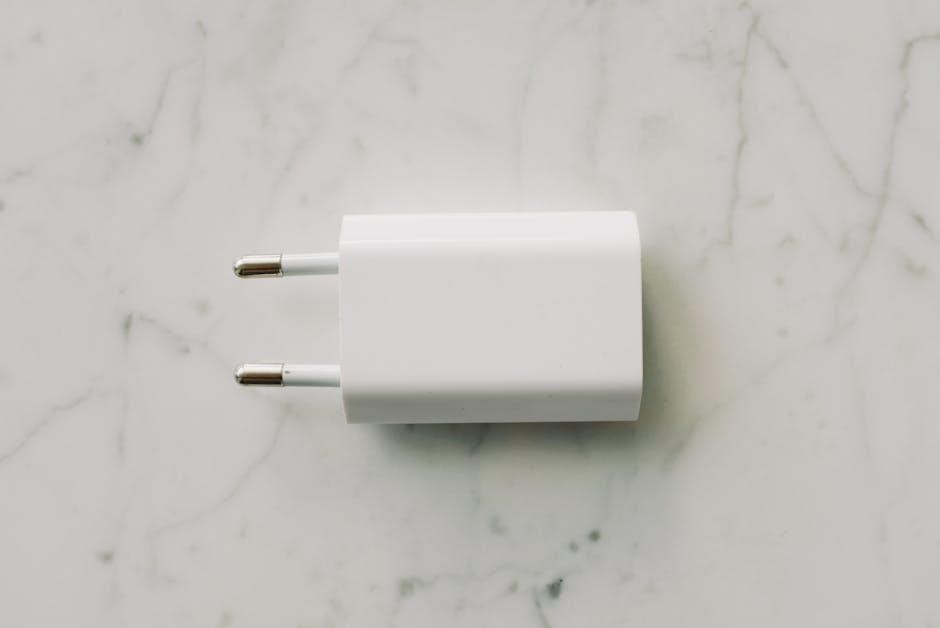Understanding the power consumption of household appliances is increasingly important in today’s world․ This is vital due to rising energy costs and growing environmental concerns․ Appliances range from small phone chargers to energy-intensive clothes dryers, impacting energy bills․

Understanding Power Consumption Metrics
To effectively manage appliance energy usage, it’s crucial to understand key metrics․ Wattage indicates instantaneous power draw․ Kilowatt-hours (kWh) measure total energy consumed over time․ Standby power, or phantom load, significantly contributes to overall consumption․
Wattage vs․ Kilowatt-hours (kWh)
Wattage measures the instantaneous power an appliance uses at any given moment, reflecting how much electricity it needs to operate․ Kilowatt-hours (kWh), on the other hand, represent the total amount of energy consumed over a specific period, typically an hour․ Understanding the difference between these metrics is essential for managing energy consumption effectively․ Appliances with high wattage consume more power instantly, while kWh reflects cumulative usage and contributes directly to electricity bills․ To estimate appliance running costs, you need both the power rating (wattage) and the electricity unit rate․
Standby Power Consumption (Phantom Load)
Standby power consumption, also known as phantom load, refers to the electricity that appliances consume even when they are turned off․ Many electronic devices continue to draw power to maintain settings, receive remote signals, or remain in a ready state․ This seemingly insignificant energy waste can add up over time, contributing to higher electricity bills․ Studies have shown that standby power can account for a notable percentage of a household’s annual electricity usage․ Minimizing phantom load by unplugging devices when not in use helps reduce energy waste․
Factors Affecting Appliance Power Usage
Several factors influence how much power an appliance consumes․ These encompass the appliance’s age and efficiency, usage patterns, and model variations․ Understanding these aspects is essential for managing energy consumption and reducing costs effectively․
Appliance Age and Efficiency
The age of an appliance significantly impacts its energy efficiency․ Older models often lack the energy-saving technologies found in newer appliances․ Consequently, older appliances consume more power to perform the same tasks․ Newer appliances adhere to stricter energy efficiency standards, reducing energy usage․ Over time, older appliances may also experience wear and tear, further decreasing their efficiency․ Regularly upgrading to energy-efficient models can lead to substantial long-term savings․ Consider replacing older appliances with Energy Star certified models for optimal energy efficiency․
Usage Patterns and Duration
How frequently and for how long appliances are used directly affects their power consumption․ Appliances used more often and for longer durations consume significantly more energy․ For instance, a refrigerator running constantly consumes more energy than one used sparingly․ Reducing usage time and modifying usage patterns can lead to substantial energy savings․ Simple changes, such as shorter showers or fewer laundry loads, can make a difference․ Being mindful of appliance usage habits is crucial for managing energy consumption effectively․ Adjusting daily routines can significantly lower energy bills and reduce environmental impact․
Model and Size Variations
Appliance power consumption varies considerably based on model and size․ Larger appliances typically consume more power than smaller ones, reflecting increased functionality or capacity․ Different models of the same appliance can have varying energy efficiencies․ Energy Star-certified models often consume less power․ Comparing energy consumption ratings before purchasing appliances is advisable․ Choosing the appropriate size appliance for your needs can prevent unnecessary energy consumption․ For example, a smaller refrigerator might suffice for a single person․ Considering model and size variations allows informed decisions about energy usage and potential savings․
Common Household Appliances and Their Power Consumption
Household appliances consume varying amounts of power, significantly affecting energy bills․ Heating appliances and large devices like refrigerators often have the highest consumption․ Understanding these differences helps in managing energy use and reducing costs effectively․
Kitchen Appliances: Refrigerators, Ovens, Microwaves
Kitchen appliances significantly contribute to household power consumption, with refrigerators operating continuously and drawing considerable energy․ Ovens, especially older models, use substantial power during heating․ Microwaves generally consume less energy but are used frequently․ Factors such as appliance age, model, and usage habits impact their individual power demands․ Newer, energy-efficient models can greatly reduce energy usage․ Understanding the power consumption of these appliances is essential for effective energy management in the kitchen․ Knowing the wattage allows for better management and reduces the total energy consumed․
Laundry Appliances: Washing Machines, Dryers
Laundry appliances, including washing machines and dryers, are notable contributors to household energy consumption․ Washing machines, particularly older models, consume significant energy, especially when using hot water cycles․ Dryers are among the most energy-intensive appliances, mainly electric dryers․ Factors like load size, frequency of use, and appliance efficiency influence overall energy consumption․ Energy-efficient models and optimized usage habits can significantly reduce energy bills․ Using cold water for washing and air-drying clothes can lessen the amount of energy utilized․ Furthermore, efficient appliances reduce power consumption․ This ultimately contributes to a more sustainable household․
Entertainment and Home Office Devices
Entertainment and home office devices contribute notably to household power consumption․ Devices such as TVs, gaming consoles, computers, and printers consume electricity while in use and even in standby mode․ The wattage of these devices varies, with larger TVs and powerful gaming consoles consuming more energy․ Standby power, also known as phantom load, can account for a surprising portion of total energy usage․ Reducing standby power by unplugging devices or using power strips can conserve energy․ Energy-efficient models and mindful usage habits, such as turning off devices when not in use, reduce power consumption․ This helps lower electricity bills․
Calculating Appliance Running Costs
Calculating appliance running costs involves understanding wattage and electricity unit rates․ This calculation helps estimate daily and monthly energy consumption․ By knowing these costs, consumers can make informed decisions about appliance usage and potential energy savings․
Using Wattage and Electricity Unit Rate
To calculate running costs, you need the appliance’s power rating (in watts) and your electricity unit rate (cost per kWh)․ The formula to estimate hourly cost is: (Power rating (W) x Electricity unit rate (p/kWh)) / 1000․ Remember, wattage can vary between models; check appliance tags for precise figures․ Accurately determining wattage allows for better estimation of energy consumption․
Estimating Daily and Monthly Consumption
To estimate daily consumption, multiply the appliance’s wattage by the hours used per day․ Divide the result by 1000 to get kilowatt-hours (kWh)․ For monthly consumption, multiply the daily kWh by the number of days in the month․ This calculation helps you understand how much each appliance contributes to your overall energy bill․ Remember, these are estimates and actual consumption may vary․

Strategies for Reducing Appliance Power Consumption
To reduce appliance power consumption, choose energy-efficient models and optimize usage habits․ Unplugging devices when not in use minimizes standby power consumption․ These strategies can significantly lower energy bills and environmental impact․
Choosing Energy-Efficient Models
Selecting energy-efficient appliances is crucial for reducing household power consumption․ Look for appliances with energy star ratings, as they consume less power․ These models often have advanced technologies that minimize energy usage without compromising performance․ Consider the long-term savings when purchasing appliances, as energy-efficient models will reduce your electricity bills over time․ Replacing older, less efficient appliances with newer, energy-saving models can significantly lower your overall energy footprint and help contribute to a more sustainable lifestyle․ Also, check for rebates and incentives offered by utility companies for purchasing energy-efficient appliances․
Optimizing Usage Habits
Optimizing appliance usage habits can significantly decrease power consumption․ Run appliances like washing machines and dishwashers during off-peak hours․ This reduces strain on the electrical grid and may lower energy costs․ Fully load washing machines and dishwashers to maximize efficiency per cycle․ Avoid pre-heating ovens longer than necessary and turn them off a few minutes before the cooking time ends․ Defrost food in the refrigerator instead of using the microwave․ These small adjustments in daily routines can lead to substantial energy savings and reduce your overall environmental impact over time․
Unplugging Devices When Not in Use
Unplugging devices when not in use is a simple yet effective strategy to combat standby power consumption․ Many electronics continue to draw power even when turned off, contributing to a “phantom load․” Chargers, TVs, and computers are common culprits․ Using power strips can simplify the process of disconnecting multiple devices at once․ Make it a habit to unplug appliances when leaving for extended periods․ This proactive approach prevents unnecessary energy waste and reduces your household’s electricity bill․ By minimizing phantom loads, you contribute to energy conservation․

Resources for Finding Appliance Power Consumption Data
Finding reliable appliance power consumption data is easy with several available resources․ These resources include appliance labels, owner’s manuals, online charts, PDFs, and energy monitoring devices․ Using these resources ensures accuracy in energy usage calculations․
Appliance Labels and Owner’s Manuals
Appliance labels and owner’s manuals are primary sources for understanding an appliance’s power consumption․ These resources provide specific wattage and voltage ratings, essential for calculating energy usage․ Consulting these documents can help consumers to estimate energy consumption accurately․ The wattage listed on the appliance or in its manual indicates the power it consumes during operation․ Remember that some appliances might have varying power consumption depending on their operational mode, so check the documentation to get the precise figures for all modes․ Referencing these materials before calculating energy costs is highly recommended․
Online Power Consumption Charts and PDFs
Online power consumption charts and PDFs provide valuable information for estimating appliance energy usage․ These resources typically list common household appliances․ The typical or average wattage and estimated kilowatt usage are also given․ Many websites and organizations offer downloadable charts and PDFs summarizing appliance power consumption data․ These resources provide wattage ratings for various appliances, aiding in energy consumption calculations․ These charts can help consumers compare the energy usage of different appliances․ However, it is crucial to verify the accuracy of the data․ Always ensure that the data source is reputable and up-to-date before relying on it․
Energy Monitoring Devices
Energy monitoring devices offer a precise way to track appliance power consumption in real-time․ These devices measure the actual energy used by individual appliances․ This provides detailed insights into usage patterns․ Smart plugs and whole-house energy monitors are common examples․ Smart meters measure energy consumption and provide online readings․ These devices can measure energy consumption and provide online readings on electricity usage․ Energy monitoring devices enable users to identify energy-hungry appliances․ They also help optimize usage habits․ By tracking real-time data, users can make informed decisions to reduce energy waste and lower electricity bills․

The Impact of Appliance Power Consumption on Household Energy Bills
Appliance power consumption significantly influences household energy bills, representing a substantial portion of monthly expenses․ Understanding the energy usage of appliances is crucial for effective energy management․ High-wattage appliances, such as refrigerators and dryers, contribute substantially to energy costs․ Standby power, or phantom load, from devices also adds to the overall bill․ Monitoring appliance usage and identifying energy-intensive devices is essential for reducing costs․ By optimizing usage habits and choosing energy-efficient models, households can lower their energy consumption․ Reducing energy waste directly translates to lower monthly electricity bills․
Future Trends in Appliance Energy Efficiency
Future trends in appliance energy efficiency point toward innovative technologies aimed at minimizing power consumption․ Smart appliances with energy monitoring capabilities will become more prevalent, allowing users to track and optimize their energy use․ Advancements in materials and design will lead to more efficient appliances with reduced standby power consumption․ Integration of renewable energy sources, like solar power, will further decrease reliance on traditional electricity grids․ Government regulations and incentives will drive manufacturers to develop and promote energy-efficient models․ These changes will result in lower energy bills and reduced environmental impact․